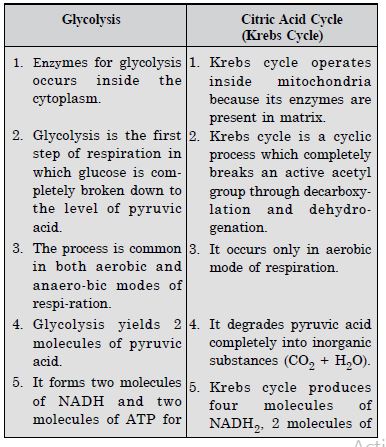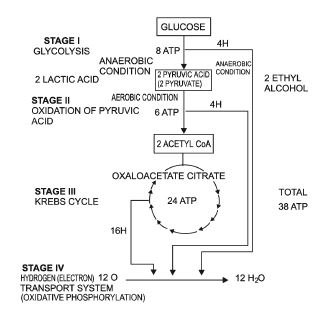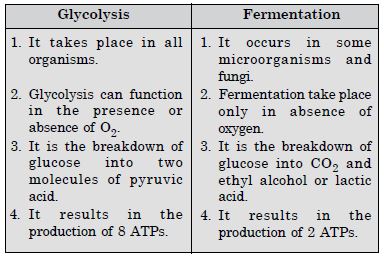The free NCERT Solutions at Aasoka are prepared by experts as per the latest CBSE syllabus. This acts as an educational resource designed to help students get ready for their school as well as competitive exams. Students can boost their learning capacity through these NCERT Solutions for Class 12 and achieve good scores. It helps you get familiar with the exam pattern and makes you learn time management during exams.
The chapter “Respiration in Plants” of Biology Class 11 teaches fermentation, the respiratory balance sheet, exchange of gases, amphibolic pathways, glycolysis, cellular respiration, aerobic respiration, respiratory quotient, TCA cycle, fermentation, and much more.
Question 1:
Differentiate between
- Respiration and combustion
- Glycolysis and Krebs cycle
Answer:
- Differences between respiration and combustion
- Differences between Glycolysis and Krebs cycle
Question 2:
What are respiratory substrates ? Name the most common respiratory substrate.
Answer:
Respiratory substrate. The com-pounds that are oxidised during respiration are known as respiratory substrates.
Glucose is the most common substrate used in cellular respiration. Glycogen and sugars other than glucose are broken down to glucose and fed into glycolysis.
Question 3:
What are the main steps in aerobic respiration ? Where does it take place ?
Answer:
The main steps in aerobic respiration are :
- Glycolysis.
- The complete oxidation of pyruvate by the stepwise removal of all the hydrogen atoms, leaving three molecules of CO2.
- Krebs cycle. (Tricarboxylic acid cycle)
- The passing on of the electrons removed as part of the hydrogen atoms to molecular O2 with simultaneous synthesis of ATP.
The first of these takes place in the matrix of the mitochondria while the second process is located on the inner membrane of the mitochondria.
Outline of cell respiration.
Question 4:
Give the schematic representation of an overall view of Krebs cycle.
Answer:
Krebs cycle.
Schematic representation of Krebs cycle.
Question 5:
Explain ETS.
Answer:
Electron transport system is operative in inner mitochondria membrane. (Fig. 14.4).
The pairs of hydrogen atoms removed from respiratory intermediates by dehydrogenation reactions during glycolysis and Krebs’ cycle do not directly react with oxygen. These are used to reduce pH acceptor molecules such as NAD+ and FAD to NADH2 and FADH2.
These reduced coenzymes release the protons (H+) in the mitochondrial matrix, while the electrons (e–) are channeled into electron-transport chain (mitochondrial respiratory chain).
ETCs a set of seven electron-carriers present in a specific sequence along inner mitochondrial membrane.
These seven electron-carriers function in a specific sequence and are :
1. Nicotinamide Adenine Dinucleotide (NAD),
2. Flavin Mononucleotide (FMN),
Question 6:
Distinguish between the following :
Glycolysis and fermentation
Answer:
Differences between glycolysis and fermentation
Question 7:
What are the assumptions made during the calculation of net gain of ATP ?
Answer:
It is possible to make calculations of the net gain of ATP for every glucose molecule oxidised; but in reality this can remain only a theoretical exercise. These calculations can be made only on certain assumptions that :
- There is a sequential,orderly pathway functioning, with one substrate forming the next and with glycolysis, TCA cycle and ETS pathway following one after another.
- The NADH synthesised in glycolysis is transferred into the mitochondria and undergoes oxidative phosphorylation.
- None of the intermediates in the pathway are utilised to synthesise any other compound.
- Only glucose is being respired – no other alternative substrates are entering in the pathway at any of the intermediary stages.
Question 8:
Discuss ‘‘The respiratory pathway is an amphibolic pathway.’’
Answer:
Because the respiratory pathway is involved in both anabolism and catabolism, it would hence be better to consider the respiratory pathway as an amphibolic pathway. Fatty acids would be broken down to acetyl CoA before entering the respiratory pathway when it is used as a substrate. But when the organism needs to synthesise fatty acids, acetyl CoA would be withdrawn from the respiratory pathway for it. Hence the respiratory pathway comes into the picture both during breakdown and synthesis of fatty acids. Similarly during breakdown and synthesis of protein too, respiratory intermediates form the link. Breaking down processes within the living organism is catabolism, and synthesis is anabolism.
Question 9:
Define R.Q. What is its value for fats ?
Answer:
Respiratory Quotient (R.Q.). The ratio of volume of CO2 evolved to the volume of oxygen consumed per unit time per unit weight. R.Q. indicates the type of respiratory substrate being used and type of respiration being performed. R.Q. value is one for aerobic respiration of glucose; more than one for organic acids (e.g. 1.3 for malic acid and 1.14 for succinic acid), less than one for fats (0.7) and proteins (0.85); infinity for anaerobic respiration (as no oxygen is used). It can be measured by respirometer.
Question 10:
What is Oxidative phos- phorylation.
Answer:
The generation of ATP from ADP during electron transport system by utilizing the energy obtained during oxidative reaction is called oxidative phosphorylation.
Question 11:
What is the significance of stepwise release of energy in respiration ?
Answer:
Anaerobic and aerobic respiration are conducted in many steps and energy is released in steps. The advantages of stepwise release of energy are :
- It facilitates the utilization of the relatively higher proportion of the energy in ATP synthesis.
- Activities of enzymes for the different steps may be enhanced or inhibited by specific compounds. This provides a mean of controlling the rate of the pathway and the energy output according to the need of the cell.
- The same pathway may be utilized for forming intermediates used in the synthesis of other biomolecules like amino acids.






